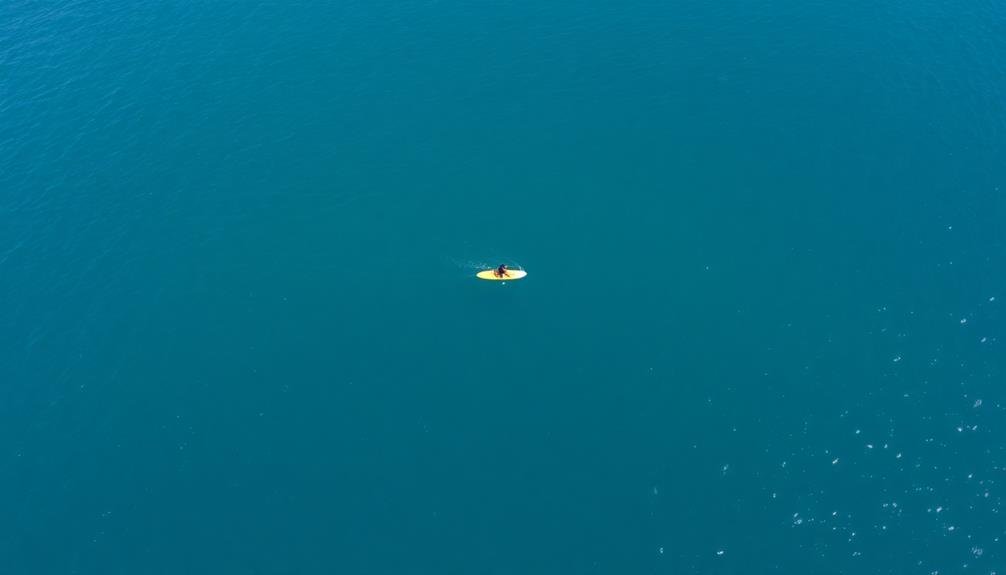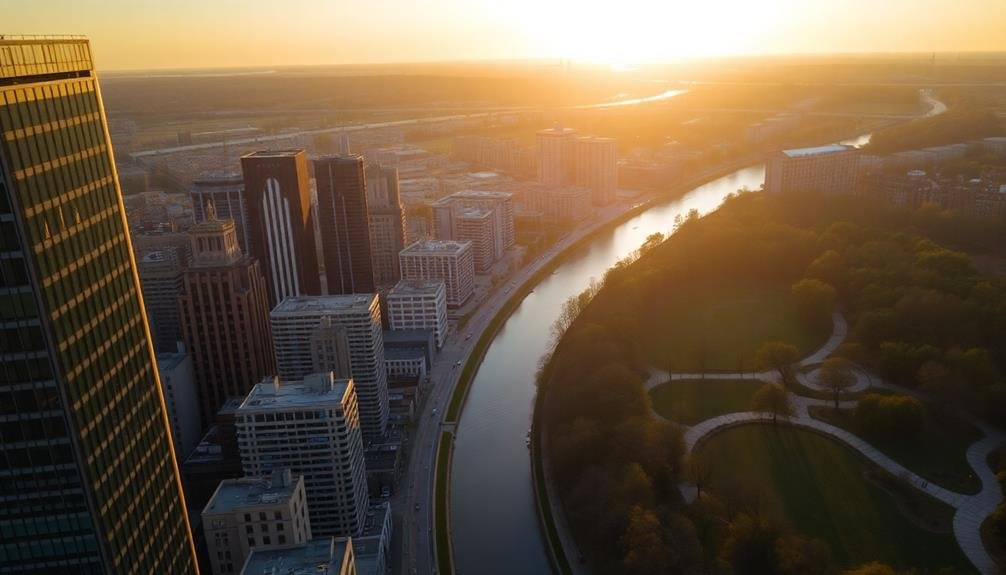To achieve balanced elements in sky-high shots, start by applying the Rule of Thirds to your composition. Incorporate leading lines like roads or rivers to guide the viewer's eye through the image. Balance foreground and background elements, using interesting objects to anchor your shot while considering the backdrop. Leverage symmetry and patterns to create visually striking images, but don't be afraid to break symmetry for added interest. Finally, play with negative space to emphasize your subject and convey a sense of scale. These tips will help you capture stunning aerial photographs that stand out from the crowd. Discover how these techniques can elevate your drone photography to new heights.
Key Takeaways
- Apply the rule of thirds to position key elements along gridlines or intersections.
- Incorporate leading lines to guide the viewer's eye through the composition.
- Balance foreground and background elements for depth and visual interest.
- Utilize symmetry and patterns to create harmony in aerial compositions.
- Leverage negative space to emphasize subjects and convey a sense of scale.
Use the Rule of Thirds

Almost every photographer has heard of the rule of thirds, but it's especially crucial in aerial photography. When you're capturing images from above, this principle becomes even more powerful in creating balanced and visually appealing compositions.
To apply the rule of thirds, imagine dividing your frame into a 3×3 grid. Place key elements along these lines or at their intersections to create a more dynamic and interesting shot.
In sky-high photography, you'll often have vast expanses of sky, land, or water to work with. Use the rule of thirds to position the horizon along the upper or lower horizontal line, depending on whether you want to emphasize the sky or the ground.
For subjects like buildings, roads, or natural features, align them with vertical lines or intersections to add visual interest and flow to your image.
Don't be afraid to experiment with off-center compositions. Placing your main subject slightly off to one side can create a sense of movement and draw the viewer's eye through the frame.
Incorporate Leading Lines

Incorporating leading lines in aerial photography can transform your images from ordinary to extraordinary. These visual pathways guide the viewer's eye through the composition, creating depth and directing attention to your main subject. When shooting from above, you'll find an abundance of natural and man-made lines to work with.
Look for roads, rivers, coastlines, or even rows of trees to serve as leading lines. Position your drone to capture these elements in a way that draws the eye into the frame. Experiment with different angles and heights to find the most compelling composition. Remember, leading lines don't always have to be straight; curves and S-shapes can add dynamic interest to your shots.
Here's a quick reference guide for incorporating leading lines in aerial photography:
| Line Type | Examples | Effect |
|---|---|---|
| Straight | Roads, bridges | Direct, powerful |
| Curved | Rivers, coastlines | Graceful, natural |
| Diagonal | Mountain ridges | Dynamic, energetic |
| Converging | Railway tracks | Depth, perspective |
| Radial | Roundabouts, plazas | Focal point, symmetry |
Balance Foreground and Background Elements

Harmony between foreground and background elements is essential for creating compelling aerial photographs. When shooting from above, you'll often have a vast canvas to work with, so it's vital to carefully consider how you frame your shot.
Start by identifying interesting foreground elements that can anchor your image and provide context. These could be buildings, trees, roads, or even people if you're flying at a lower altitude.
Next, assess the background elements and how they complement or contrast with the foreground. Look for patterns, textures, or colors that create visual interest. You'll want to strike a balance between the two, ensuring neither overpowers the other.
Use the rule of thirds to help position key elements within your frame, placing points of interest at the intersections of imaginary gridlines.
Consider the scale of objects in your composition. By including elements of different sizes, you can create a sense of depth and dimension in your aerial shots.
Don't forget to pay attention to shadows, which can add drama and context to your images, especially during golden hour or when shooting in low light conditions.
Leverage Symmetry and Patterns

Symmetry and patterns are powerful tools in aerial photography that can transform ordinary scenes into enchanting compositions. When you're capturing sky-high shots, look for natural or man-made elements that create visual harmony. Seek out repetitive structures, geometric shapes, or mirror-like reflections to add a sense of balance and order to your images.
To effectively leverage symmetry and patterns in your aerial photography:
- Scout for locations with inherent symmetry, such as perfectly aligned buildings, neatly arranged agricultural fields, or naturally occurring fractal patterns in landscapes.
- Use leading lines and repeating elements to guide the viewer's eye through the frame, creating a sense of depth and movement in your composition.
- Experiment with different angles and altitudes to find the perfect perspective that highlights symmetrical features or reveals hidden patterns invisible from ground level.
Don't be afraid to break symmetry intentionally to create visual interest. A single element that disrupts an otherwise perfect pattern can serve as a compelling focal point.
Play With Negative Space

Negative space can be a powerful tool in aerial photography, allowing you to create striking images that draw the viewer's eye. When shooting from above, you'll often encounter vast expanses of sky, water, or open land that can serve as perfect negative space. Use these areas to your advantage by positioning your main subject against them.
Look for opportunities to frame your subject with negative space on multiple sides. This can create a sense of isolation or emphasize the subject's significance. Try placing your subject off-center, using the rule of thirds to guide your composition. The empty space will naturally lead the viewer's gaze to the focal point.
Don't be afraid to let negative space dominate your shot. A small subject surrounded by a large expanse can create a powerful sense of scale and perspective. Experiment with different altitudes to find the perfect balance between your subject and the surrounding space.
Consider the color and texture of your negative space. A clear blue sky or calm water can provide a clean, minimalist backdrop, while textured landscapes can add depth and interest to your composition.
Frequently Asked Questions
What Equipment Is Essential for Capturing High-Quality Sky-High Shots?
You'll need a high-resolution camera, wide-angle lens, and sturdy tripod for sky-high shots. Don't forget a remote shutter release to minimize vibrations. A drone can offer unique perspectives, but check local regulations first.
How Can I Ensure Proper Exposure in Challenging Lighting Conditions?
To guarantee proper exposure in challenging lighting, you'll want to use manual mode, bracket your shots, and utilize filters. Don't forget to check your histogram, expose for highlights, and consider HDR techniques for tricky situations.
Are There Specific Weather Conditions That Enhance Sky-High Photography?
You'll find clear, sunny days ideal for sky-high photography. But don't overlook dramatic clouds, golden hour light, or even storms. They can add depth and interest. Experiment with different conditions to capture unique perspectives.
What Post-Processing Techniques Can Improve Sky-High Images?
You'll enhance your sky-high images with post-processing techniques like adjusting contrast, boosting saturation, and fine-tuning highlights and shadows. Don't forget to sharpen details, reduce noise, and experiment with HDR for stunning results.
How Do I Maintain Image Sharpness When Shooting From Extreme Heights?
To maintain image sharpness from extreme heights, you'll want to use a fast shutter speed, stabilize your camera, and shoot in RAW. Don't forget to adjust your focus and aperture for ideal depth of field.
In Summary
You've now got the tools to create stunning sky-high shots. Remember, it's all about balance and composition. As you're framing your next aerial masterpiece, keep these tips in mind. Experiment with the rule of thirds, seek out leading lines, and find harmony between foreground and background elements. Don't forget to play with symmetry and negative space. With practice, you'll soon be capturing breathtaking aerial images that'll leave viewers in awe. So get out there and start shooting!

As educators and advocates for responsible drone use, we’re committed to sharing our knowledge and expertise with aspiring aerial photographers.




Leave a Reply